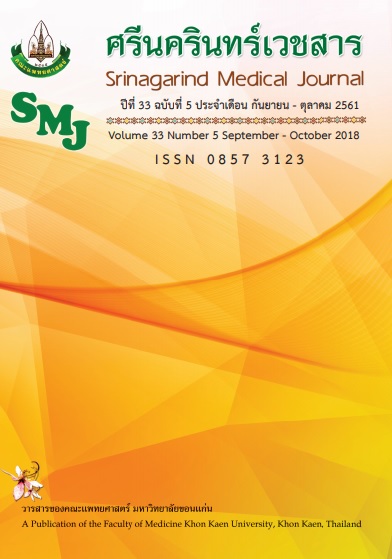Prevalence and Factors Associated with Musculoskeletal Disorders among Tea Farmers, Thoet Thai Subdistrict, Mae Fa Luang District, Chiang Rai Province
Keywords:
MusculoskeletalAbstract
ความชุกและปัจจัยที่มีความสัมพันธ์กับกลุ่มอาการผิดปกติทางระบบโครงร่างและกล้ามเนื้อในเกษตรกรเก็บใบชา ตำบลเทอดไทย อำเภอแม่ฟ้าหลวง จังหวัดเชียงราย
พรพิรมย์ ทัศนาวงค์1, วิโรจน์ จันทร2, จุฑารัตน์ รักประสิทธิ์2
1 นิสิตปริญญาตรี สาขาวิชาอาชีวอนามัยและความปลอดภัย คณะสาธารณสุขศาสตร์ มหาวิทยาลัยนเรศวร จังวัดพิษณุโลก
2 กลุ่มสาขาอนามัยสิ่งแวดล้อมและอาชีวอนามัย คณะสาธารณสุขศาสตร์ มหาวิทยาลัยนเรศวร
จังวัดพิษณุโลก
หลักการและวัตถุประสงค์: กลุ่มอาการผิดปกติทางระบบโครงร่างและกล้ามเนื้อพบมากขึ้นในกลุ่มเกษตรกรการศึกษานี้มีวัตถุประสงค์เพื่อศึกษาความชุกของกลุ่มอาการผิดปกติทางระบบโครงร่างและกล้ามเนื้อและความสัมพันธ์ระหว่างปัจจัยด้านการยศาสตร์และกลุ่มอาการผิดปกติทางระบบโครงร่างและกล้ามเนื้อในกลุ่มเกษตรกรเก็บใบชา
วิธีการศึกษา: การศึกษานี้เป็นการศึกษาเชิงพรรณนาภาคตัดขวางในเกษตรบ้านพญาไพรเล่ามา บ้านพญาไพรเล่าจอ และบ้านพญาไพรลิทู่ ตำบลเทอดไทย อำเภอแม่ฟ้าหลวง จังหวัดเชียงราย จำนวน 167 ราย เก็บข้อมูลด้วยวิธีการสุ่มตัวอย่างแบบหลายขั้นตอน ในระหว่างเดือนกรกฎาคมถึงกันยายน พ.ศ. 2558 ด้วยแบบสอบถาม 1) แบบสอบถามการสัมผัสปัจจัยการยศาสตร์ และ 2) แบบสอบถามกลุ่มอาการผิดปกติระบบโครงร่างและกล้ามเนื้อปรับปรุงจากแบบสอบถามมาตรฐานนอร์ดิค และวิเคราะห์สถิติเชิงอนุมานด้วยสถิติไคสแควร์ เพื่อวิเคราะห์ความสัมพันธ์ของปัจจัยด้านการยศาสตร์และกลุ่มอาการผิดปกติทางระบบโครงร่างและกล้ามเนื้อ
ผลการศึกษา: พบว่าความชุกของกลุ่มอาการผิดปกติทางระบบโครงร่างและกล้ามเนื้อในช่วง 7 วันและ 12 เดือนที่ผ่านมา เท่ากับ ร้อยละ 46.7 และ 85.0 ตามลำดับ โดยในช่วง 7 วัน พบอาการผิดปกติมากที่สุด บริเวณหลังส่วนล่าง (ร้อยละ 67.7) บริเวณหัวเข่า (ร้อยละ 42.5) และบริเวณไหล่ (ร้อยละ 41.3) ตามลำดับ ในช่วง 12 เดือนที่ผ่านมาพบอาการผิดปกติมากที่สุด บริเวณหลังส่วนล่าง (ร้อยละ 88.0) บริเวณไหล่ (ร้อยละ 61.7) และบริเวณคอ (ร้อยละ 50.3) ปัจจัยด้านการยศาสตร์ พบว่า ด้านท่าทางการทำงานไม่เหมาะสม ร้อยละ 65.3 และด้านท่าทางการทำงานซ้ำซากที่ทำเป็นระยะเวลานานเกิน 2 ชั่วโมงต่อวัน ร้อยละ 78.4 ผลการวิเคราะห์ทางสถิติ พบความสัมพันธ์กันอย่างมีนัยสำคัญทางสถิติ (p<0.05) ระหว่างปัจจัยด้านการยศาสตร์และอาการผิดปกติระบบโครงร่างและกล้ามเนื้อในช่วง 12 เดือนที่ผ่านมา
สรุป: ผลการศึกษาชี้ให้เห็นว่าปัจจัยสำคัญที่ทำให้เกิดอาการผิดปกติระบบโครงร่างและกล้ามเนื้อจากการทำงานเป็นปัญหาในเกษตรกรผู้เก็บใบชา ปัจจัยด้านท่าทางการทำงานที่ไม่เหมาะสมและท่าทางการทำงานซ้ำซากทำเป็นระยะเวลานานเกิน 2 ชั่วโมงต่อวัน ควรนำมาพิจารณาประกอบเพื่อปรับปรุงขั้นตอนการทำงานและท่าทางการทำงาน
Background and Objective: Musculoskeletal disorders are more prevalent among farmers. The purpose of this study was to investigate the prevalence of musculoskeletal disorders and the relationship between ergonomic factors and musculoskeletal disorders.
Method: This study was the cross-sectional descriptive study. The 167 tea farmers, Ban Phaya Phrai Lao Ma, Ban Phaya Phrai Lao Cho, and Ban Phaya Phrai Li Thu, Thoet Thai subdistrict, Mae Fa Luang district, Chiang Rai province. The data were collected from the multi-stage random sampling during July to September 2015 by using questionnaires, 1) questionnaire about exposure to ergonomic factors and 2) musculoskeletal disorders with a modified Standardized Nordic Questionnaire and inferential statistical analysis was chi-square test to analyze the relationship between ergonomic factors and musculoskeletal disorders.
Results:The results of the study showed that prevalence of musculoskeletal disorders in the past 7 days and 12 months were 46.7% and 85.0%, respectively. In the past 7 days, the highest prevalence was the lower back (67.7%), followed by knee (42.5%) and shoulders (41.3%), respectively. In the past 12 months, the highest prevalence was the lower back (88.0%), followed by shoulders (61.7%) and neck (50.3%). Ergonomic factors found that inappropriate posture factor was 65.3% and repetitive working posture for more than 2 hours per day was 78.4%. The result of the statistical analysis was found the significant association (p<0.05) between ergonomic factors and musculoskeletal disorders in the past 12 months.
Conclusion: The findings indicate the important factors rerated to work-related musculoskeletal disorders were the problem among farmers who engaged in collecting tea leaves. Inappropriate posture factor and repetitive working posture for more than 2 hours per day should be considered to improve the working process and posture.


